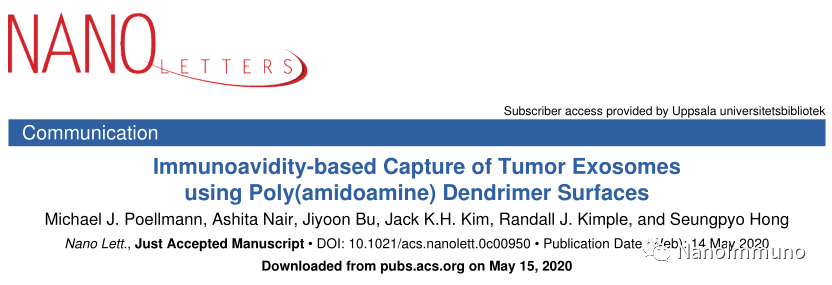Nano Lett: Design a dendrimer with immunoaffinity to capture tumor-derived exosomes

New technologies for cancer diagnosis and prognosis will promote the practice of precision medicine. Liquid biopsies are considered such a technique because they are minimally invasive and can often be performed with a simple blood draw. These tests are designed to detect biomarkers that tumors regularly enter the bloodstream, such as free DNA (cfDNA), circulating tumor cells (CTCs), or extracellular vesicles (EVs) including exosomes. Although CTCs can obtain the most information in biomarkers, these cells are very rare and heterogeneous in phenotype, which makes clinically meaningful detection and analysis very difficult. In contrast, cfDNA is relatively easy to be detected in the blood due to its abundance, however, it cannot provide dynamic information about changes in gene expression. Exosomes lie between these two more exploratory biomarkers in terms of size, abundance, and potential diagnostic information, and represent a new class of cancer biomarkers found in the blood. These nano-scale vesicles contain functional mRNA packaged in membranes with the same characteristic surface markers as the cells from which they originated. In addition, the existing literature has linked the composition and release rate of exosomes with malignant tumors and metastasis, indicating the great potential of these vesicles as prognostic biomarkers.
The current gold standard technique for separating exosomes from blood is ultracentrifugation, which is a slow, difficult to use and non-specific technique. Other commercially available methods include precipitation and size-based filtration technologies such as ExoQuick and Exospin. However, each of these methods lacks specificity for tumor-derived exosomes. On the contrary, in addition to high sensitivity and better sample preservation, methods based on immunoaffinity can also provide this selectivity. Immunoaffinity technology uses exosomes or cancer-targeting antibodies, usually located on the surface of magnetic beads or into microfluidic channels. However, these immunoaffinity-based methods completely rely on the binding affinity of the capture antibody. Due to their insufficient sensitivity and specificity, they have not yet produced significant clinical effects. The author uses multivalent immune recognition to mediate binding affinity of the nanostructured polymer surface, which can significantly improve the sensitivity and specificity of the exosome immunoaffinity device. The CTCs liquid biopsy device previously reported by the author is partly based on a surface coated with polyamidoamine (PAMAM) dendrimers, which effectively mediate the multivalent binding effect, thereby increasing Capture efficiency of the CTCs. These flexible, hyperbranched nanoparticles facilitate multivalent capture in two ways: the high density of functional groups allows multiple antibodies to be attached to each ~9 nm dendrimer; and the structure is deformed enough to accommodate the binding domain Redirect. However, the diameter of exosomes is 1/100 of CTCs. The smaller size requires the development of a new capture surface to achieve such capture based on multivalent binding at the nanometer scale.
On May 14, Nano Letters published an exosome capture surface designed by the Seungpyo Hong team from the University of Wisconsin-Madison that contains a three-layer polymer designed to minimize non-specific binding while providing multivalence. And a high degree of flexibility in antibody positioning. First, the epoxy functionalized glass sheet was coated with partially carboxylated 7th generation PAMAM dendrimer. Then, the mixture of polyethylene glycol (PEG) is coupled to the dendrimer and any remaining epoxide groups. The polyethylene glycol mixture consists of heterobifunctional polyethylene glycol (PEG) with molecular weights of 5 kDa and 20 kDa coupled with another layer of dendrimers, and 2 kDa methoxy-polyethylene glycol (MPEG ) Block non-specific adsorption. Finally, the second layer of carboxylated PAMAM dendrimer is covered on the tether to form a two-layer dendrimer surface. The following figure shows a, a separate PEG tether; b, the author previously captured the surface sum (single-layer dendrimers) ; c, the surface of the double-layer dendrimer described here.

The results show that the surface configuration of the nano-structured double-layer dendrimer achieves significantly enhanced capture of exosomes through the multivalent binding effect. Compared with previous CTCs capture surface of the author, this study showed that the second layer of dendrimers significantly improved the binding affinity at the nanometer scale, allowing it to efficiently capture tumors from cell culture fluids and blood samples from HNSCC patients For exosomes, the authors also quantitatively measured this binding force by using atomic force microscopy (AFM). Although this capture surface needs further development and optimization before it can be used clinically, the results show that the dendrimer surface can greatly improve the resistance to exosomes and other nano-scale biomarkers in plasma by using strong binding affinity. Detection. The successful development of liquid biopsy biomarkers will ultimately contribute to the realization of precision medicine.
This information is sourced from the Internet for academic exchanges only. If there is any infringement, please contact us to delete it immediately.
18915694570
Previous: [NML review] Multivari


